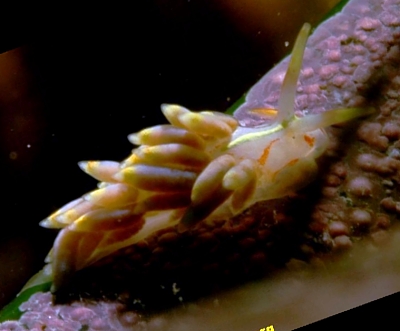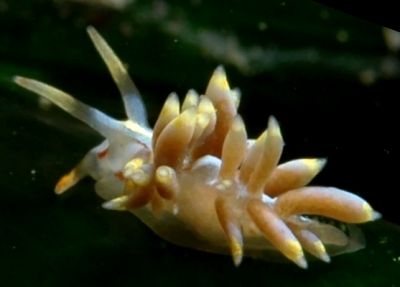

Cuthona genovae
O'Donoghue, 1926
Order: NUDIBRANCHIA
Suborder: AEOLIDINA
Family: Tergipedidae
DISTRIBUTION
Relatively common in the Mediterranean Sea. Also occurs in the east Atlantic as far north as Western Ireland.
PHOTO
Illa Mateua, L'Escala, Costa Brava, Spain. September 19, 2008 The animal was feeding on the leaves of the plant Posidonia oceanica, in less than 5 meters of depth. Estimated size is less than 10 mm. Photo: Miquel Pontes.
Small tergipedid aeolid growing to approx. 6 mm in length. The body is translucent clear with a pattern opaque white pigmentation, either as a fine dusting or a scattering of larger white spots. There is a distinctive symmetrical pattern of orange streaks, one each side running from the oral tentacles to the anterior base of the rhinophores, another from the posterior base of the rhinophores to the first ceratal cluster, and a third which runs back from the first ceratal cluster to the second and then angles in behind the heart to meet its counterpart from the other side in the midline. There is also an orange band running across the front of the head between the oral tentacles. In some cases the orange pigmentation is not clear and the places where they normally occur appear as a dark translucent clear streak, devoid of white pigmentation. There is usually a broad yellow median band running from between the rhinophores back to the heart. The upper half of the rhinophores and oral tentacles are yellow and the lower half is opaque white, with a uncoloured band between them. Both the rhinophores and oral tentacles can have an thin subapical orange band. The cerata have a broad subapical yellow band and can alsos have a thin orange band on the upper edge of the yellow. The rest of the ceratal wall is translucent clear, sometimes with patches of white dusting or white spots. The background colour of the cerata range from dark brown to almost yellow depending on the contents of the ceratal digestive gland.
For many years it has been confused with Trinchesia foliata which is similar in colour but lacks the median yellow line. It differs in the shape of the radular teeth (Bouchet, 1976).
- Bouchet, P. (1976) Trinchesia genovae (O'Donoghue, 1926) éolidien méconnu du littoral Méditerranéen. Beaufortia, Zoological Museum Univ. Amsterdam 26: 235-242 .
- Brown, G.H. (1980) The British species of the aeolidiacean family Tergipedidae (Gastropoda: Opisthobranchia) with a discussion of the genera. Zoological Journal of the Linnean Society 69: 225-255
- Miller, M. C. (1961) Distribution and food of the nudibranchiate Mollusca of the south of the Isle of Man. Journal of Animal Ecology, 30: 95-116.
- Miller, M. C. (2004) An appraisal of the identity of the New Zealand species of the aeolid family Tergipedidae (Gastropoda: Opisthobranchia). Journal of Natural History 38: 1183-1192.
- Picton, B. E. and Morrow, C. C. (1994) A Field Guide to the Nudibranchs of the British Isles. London, Immel Publishing Ltd. 143pp.
Rudman, W.B., 2008 (May 1) Cuthona genovae O'Donoghue, 1926. [In] Sea Slug Forum. Australian Museum, Sydney. Available from http://www.seaslugforum.net/find/cuthgeno
Related messages
Cuthona genovae, a new species for the Forum
May 1, 2008
From: Miquel Pontes

Dear Bill,
We found this nudibranch Cuthona genovae in our last dive on september 19, 2008 at Illa Mateua, L'Escala, Costa Brava, Spain. The animal was feeding on the leaves of the plant Posidonia oceanica, in less than 5 meters of depth. Estimated size is less than 10 mm. Picture by Miquel Pontes (http://marenostrum.org ).
I have two questions in hope you and/or the forum participants may clarify:
The first question is about feeding. Bibliography we have accessed is not clear about this species' feeding, because too many potential species are documented as food (Dynamena, Schmekel & Portmann, 1982: 253; Halecium delicatulum Ballesteros, Alvarez, & Mateo, 1986: 101; Halecium labrosum Ballesteros, 1991: 427; Obelia Schmekel & Portmann, 1982: 253; Salacia dismoides Ballesteros, Alvarez, & Mateo, 1986: 101; Scandia gigias Ballesteros, Alvarez, & Mateo, 1986: 101; Sertularella Schmekel & Portmann, 1982: 253; Tubularia larynx Picton & Morrow, 1994: 102). Maybe the information we have is old and there are new discoveries regarding this fact that may update our knowledge of the species.
The second question is about taxonomy. Apparently old references name this group as Trinchesia, but modern references (from 1985 onwards) name this group Cuthona. Certainly these animal's cerata look like Cuthona, with a yellow terminal ring on the cerata, but we're intrigued by the former denomination of Trinchesia, specially because this appears again in the new opisthobranch book (presumedly well documented) by Debelius and Kuiter (Nudibranchs of the World, 2007, page 349). Which would be the proper denomination for this species ?
Thanks for your help.
Best regards
Miquel Pontes
info@marenostrum.org



Dear Miquel,
Thanks for this interesting additon to the Forum. Concerning your two questions.
Food: Unfortunately the literature has many food records which are unsubstantiated. When someone records a species of nudibranch they usually include a description of its shape or colour and hopefully a drawing or photo. Unfortunately when they record a food item, they don't think it is just as necessary to describe the food or include a photo or drawing or deposit a sample in a museum collection. In the case of hydroids, it may be easier in Europe, but in less studied parts of the world, getting hydroids identified is quite difficult - there are few experts and they want to get on with their research rather than act solely as identification services. I can't say in this case, but often hydroids in the past have been incorrectly identified - and probably still are. One other problem is that hydroids often settle and grow in mixed colonies, the stalks and 'root' systems of several species being intertwined. It is quite possible to misidentify the actual hydroid an aeolid is interested in in such a situation. Another complication is that Cuthona genovae has long been confused with Cuthona foliata, which is very similar in external features (Bouchet, 1976). Greg Brown (1980) and Michael Miller (1961) report C. foliata feeding on a variety of hydroids. Picton & Morrow (1994) confirms that C. foliata feeds on various hydroids but has only found C. genovae feeding on Tubularia so it is possible that food records for C. foliata have been unintentionally added to those for C. genovae. I haven't checked for recent records and research, but since C. genovae is fairly common in the Mediterranean it could be an interesting little project for someone.
Concerning Trinchesia or Cuthona. I haven't much more to add to my earlier message [#21285]. When I wrote that, I had not seen Debelius & Kuiter but predicted that they would not give reasons or references to why they had decided to use Trinchesia. I have now seen the book and can find no references to any information in the book. In his foreward, Helmut Debelius says his books present 'scientifically proven information' but in my understanding of science, books that don't acknowledge the work of others or refer to the source of their information aren't doing their job. So I can only presume that they base their usage on Michael Miller's paper (2004). All I can repeat is that I feel there is little point in us changing present usage from Cuthona to Trinchesia until a full review of the family is undertaken and a more robust hypothesis of the phylogeny of the family developed.
-
Bouchet, P. (1976) Trinchesia genovae (O'Donoghue, 1926) éolidien méconnu du littoral Méditerranéen. Beaufortia, Zoological Museum Univ. Amsterdam 26: 235-242 .
-
Brown, G.H. (1980) The British species of the aeolidiacean family Tergipedidae (Gastropoda: Opisthobranchia) with a discussion of the genera. Zoological Journal of the Linnean Society 69: 225-255
- Miller, M. C. (1961) Distribution and food of the nudibranchiate Mollusca of the south of the Isle of Man. Journal of Animal Ecology, 30: 95-116.
- Miller, M. C. (2004) An appraisal of the identity of the New Zealand species of the aeolid family Tergipedidae (Gastropoda: Opisthobranchia). Journal of Natural History 38: 1183-1192.
- Picton, B. E. and Morrow, C. C. (1994) A Field Guide to the Nudibranchs of the British Isles. London, Immel Publishing Ltd. 143pp.
Best wishes,
Bill Rudman
